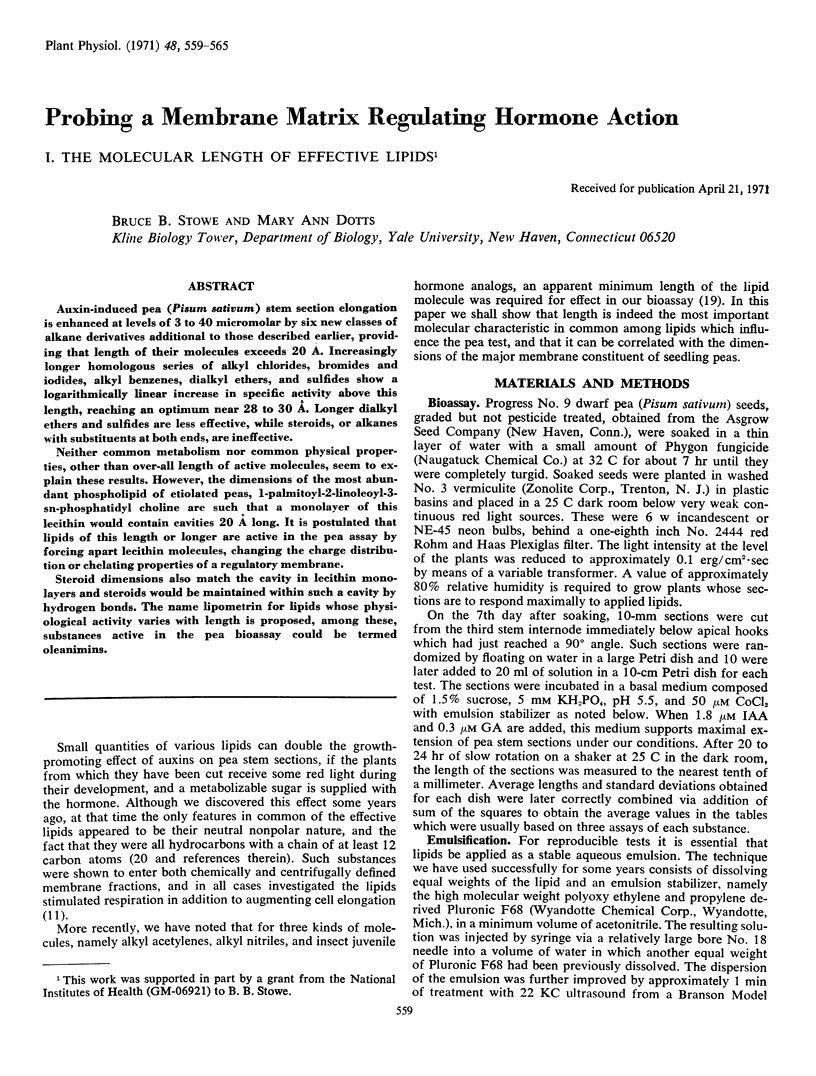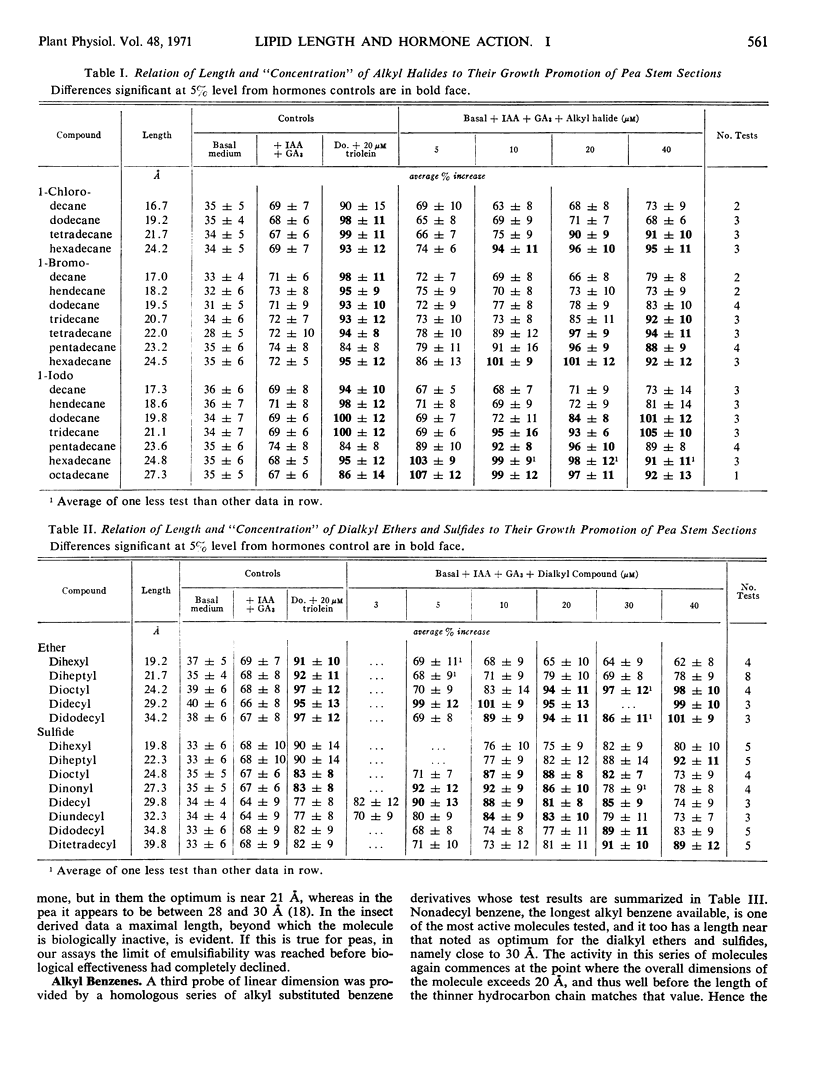Abstract
Auxin-induced pea (Pisum sativum) stem section elongation is enhanced at levels of 3 to 40 micromolar by six new classes of alkane derivatives additional to those described earlier, providing that length of their molecules exceeds 20 A. Increasingly longer homologous series of alkyl chlorides, bromides and iodides, alkyl benzenes, dialkyl ethers, and sulfides show a logarithmically linear increase in specific activity above this length, reaching an optimum near 28 to 30 Å. Longer dialkyl ethers and sulfides are less effective, while steroids, or alkanes with substituents at both ends, are ineffective.
Neither common metabolism nor common physical properties, other than over-all length of active molecules, seem to explain these results. However, the dimensions of the most abundant phospholipid of etiolated peas, 1-palmitoyl-2-linoleoyl-3-sn-phosphatidyl choline are such that a monolayer of this lecithin would contain cavities 20 Å long. It is postulated that lipids of this length or longer are active in the pea assay by forcing apart lecithin molecules, changing the charge distribution or chelating properties of a regulatory membrane.
Steroid dimensions also match the cavity in lecithin monolayers and steroids would be maintained within such a cavity by hydrogen bonds. The name lipometrin for lipids whose physiological activity varies with length is proposed, among these, substances active in the pea bioassay could be termed oleanimins.
Full text
PDF






Selected References
These references are in PubMed. This may not be the complete list of references from this article.
- Gaunt J. K., Stowe B. B. Analysis and distribution of tocopherols and quinones in the pea plant. Plant Physiol. 1967 Jun;42(6):851–858. doi: 10.1104/pp.42.6.851. [DOI] [PMC free article] [PubMed] [Google Scholar]
- Goad L. J., Goodwin T. W. The biosynthesis of sterols in higher plants. Biochem J. 1966 Jun;99(3):735–746. doi: 10.1042/bj0990735. [DOI] [PMC free article] [PubMed] [Google Scholar]
- Kolattukudy P. E., Liu T. Y. Direct evidence for biosynthetic relationships among hydrocarbons, secondary alcohols and ketones in Brassica oleracea. Biochem Biophys Res Commun. 1970 Dec 24;41(6):1369–1374. doi: 10.1016/0006-291x(70)90538-3. [DOI] [PubMed] [Google Scholar]
- Mitchell J. W., Mandava N., Worley J. F., Plimmer J. R., Smith M. V. Brassins--a new family of plant hormones from rape pollen. Nature. 1970 Mar 14;225(5237):1065–1066. doi: 10.1038/2251065a0. [DOI] [PubMed] [Google Scholar]
- Penny D., Stowe B. B. Relationship of lipid metabolism to the respiration and growth of pea stem sections. Plant Physiol. 1966 Feb;41(2):360–365. doi: 10.1104/pp.41.2.360. [DOI] [PMC free article] [PubMed] [Google Scholar]
- SCHULMAN J. H., MONTAGNE J. B. Formation of microemulsions by amino alkyl alcohols. Ann N Y Acad Sci. 1961 Jun 17;92:366–371. doi: 10.1111/j.1749-6632.1961.tb44987.x. [DOI] [PubMed] [Google Scholar]
- Schneiderman H. A., Krishnakumaran A., Kulkarni V. G., Friedman L. Juvenile hormone activity of structurally unrelated compounds. J Insect Physiol. 1965 Dec;11(12):1641–1649. doi: 10.1016/0022-1910(65)90031-4. [DOI] [PubMed] [Google Scholar]
- Stowe B. B., Hudson V. W. Growth Promotion in Pea Stem Sections. III. By Alkyl Nitriles, Alkyl Acetylenes and Insect Juvenile Hormones. Plant Physiol. 1969 Jul;44(7):1051–1057. doi: 10.1104/pp.44.7.1051. [DOI] [PMC free article] [PubMed] [Google Scholar]
- Stowe B. B., Obreiter J. B. Growth Promotion in Pea Stem Sections. II. By Natural Oils & Isoprenoid Vitamins. Plant Physiol. 1962 Mar;37(2):158–164. doi: 10.1104/pp.37.2.158. [DOI] [PMC free article] [PubMed] [Google Scholar]
- Trémolières A., Lepage M. Changes in Lipid Composition during Greening of Etiolated Pea Seedlings. Plant Physiol. 1971 Feb;47(2):329–334. doi: 10.1104/pp.47.2.329. [DOI] [PMC free article] [PubMed] [Google Scholar]
- WILLMER E. N. Steroids and cell surfaces. Biol Rev Camb Philos Soc. 1961 Aug;36:368–398. doi: 10.1111/j.1469-185x.1961.tb01295.x. [DOI] [PubMed] [Google Scholar]


